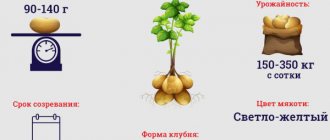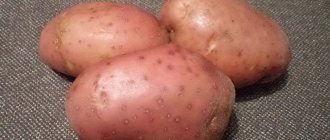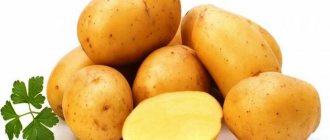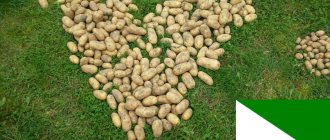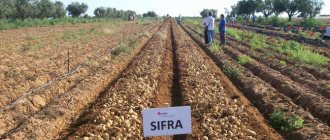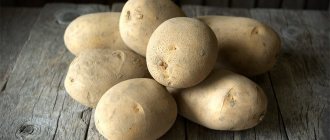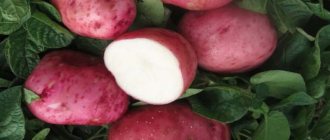Did you know that an adult Russian eats about 90 kg of potatoes per year? According to these indicators, our country ranks 5th in the world, so the statement that potatoes are the second bread is true today. According to statistics, almost half of the total crop is grown in garden plots. The economy is the economy, but no one has canceled the rule of having high-quality potato root crops in your bins. Today we will tell you about one of the most interesting varieties: Rosara Potatoes.
Description of the rose variety
When describing the variety, it should first of all be noted that Rosara has an early ripening period. This determines many of its other characteristics.
History of the variety's creation
But first, a little history. Rosara potatoes were developed in Germany at the end of the twentieth century. It was registered in Russia in 1996 and quickly gained popularity among our gardeners. And this despite the fact that to date more than a thousand varieties are grown. After zoning, the Rosara variety is grown in many regions of the country.
Characteristics
Thanks to its good characteristics, Rosara potatoes have deservedly gained popularity among gardeners
| Characteristic | Indicators |
| General characteristics | Early grade (for commercial production, packaging, washing, mechanized harvesting) |
| Ripening period | 65-70 days |
| Harvest | 400 c/ha – Russia 600 c/ha – Belarus |
| Marketability | 91-97% of the total harvest |
| Keeping quality | 97% |
| Weight of marketable tubers | 80-110 g |
| Number of tubers in the nest | Up to 20 pieces |
| Pulp | light yellow |
| Peel | red (from pink to dark crimson) |
| Starch percentage | Average 13% |
| Flowers | red-violet |
| Disease resistance | High resistance to scab, potato canker, leaf curl virus, iron spot, black leg, rhizoctonia, late blight of tubers and tops, golden nematode) |
| Culinary qualities | excellent taste, universal culinary use |
| Features of agricultural technology | good harvest in any climate and weather conditions |
Characteristics of the bush
The height of Rosara's bush is about half a meter. Compactly located shoots with green leaves. During the flowering period, small, red-violet flowers, pubescent at the base, open.
Characteristics of tubers
Each bush produces 15-20 standard-sized tubers. The color of the tubers corresponds to the name of the variety. Pink-raspberry oval-shaped compact tubers are located shallow from the soil surface. As a result, potatoes are rarely injured during harvesting.
On the surface of tubers weighing 80 - 110 grams there are relatively few shallow, no deeper than a millimeter, eyes. When cut, the potatoes will delight you with their dense yellow flesh. For an early variety, Rosara has a fairly high percentage of starch content - 13%, which is 3% higher than the average value.
Uniqueness of the variety
Ideal yield, ripening in 2 months, allowing for a second harvest in a season, resistance to diseases, ease of care and excellent taste. This is the unique characteristic of the variety. Of course, which potatoes to choose, everyone decides for themselves. But it is also worth considering that the Rosara potato variety produces a stable harvest in any climatic and weather conditions.
Taste qualities
The potatoes are not crumbly, which is very good for making salads, for fries and homemade chips. The potatoes are tasty, tender and aromatic, do not fall apart when cooked. A distinctive feature is that the potatoes do not change their taste during long-term storage.
Comparison with other varieties
| Variety | Maturation period | Harvest from 1 hundred square meters | Peel/pulp color | Advantages |
| Rosara | 65-70 days | 350-500 kg | Red skin, yellow flesh | Marketable condition. Long-term storage. Disease resistance. The first tubers ripen after 45 days. |
| Alyona | 50-60 days | 300 kg | Red skin, creamy flesh | A variety suitable for cultivation in the Western Siberian regions. Resistant to diseases. |
| Ariel | 50-70 days | 150-450 kg | Light yellow skin, creamy flesh | 2 harvests are collected per year. |
| Timo | 70 days | 240 kg | Light skin, creamy flesh | The variety is suitable for growing on different types of soil. The first root crops are obtained after 45-50 days. |
| Karatop | 50-65 days | 350-500 kg | Light skin, yellow flesh | The variety is characterized by high yield and increased resistance to diseases. |
| Bellarosa | 50-60 days | 320 kg | Light pink rough skin, yellow flesh | Increased resistance to diseases. Easy to care for. |
| Lark | 40-55 days | 250-280 kg | Bright yellow peel, soft lemon pulp | Resistance to late blight, golden nematode |
| Impala | 65-75 days | 370-600 kg | The peel and pulp are light yellow in color. | Smooth fruits “one to one”. High yield. Disease resistance. |
| Romano | 80 days | 500-600 kg | Pink peel, creamy lemon pulp | Excellent taste. Marketable condition. Good yield. |
| Lily | 50-60 days | 600-680 kg | Lemon peel, light yellow pulp | High yield. Good taste. Resistance to long-term transportation. |
| Luck | 65 days | 420 kg | Yellow peel and pulp | Increased resistance to diseases. |
| Bullfinch | 45-55 days | 400-450 kg | Pink skin, creamy flesh | Good yield. Easy to care for. High yield. |
| Charoite | 80-90 days | 320 kg | Yellow peel and pulp | Marketable condition. Harvest safety. Smooth fruits. |
| Veneta | 50-55 days | 235-240 kg | Dark brown or yellow skin, light brown flesh | Marketable condition. Undemanding to soil composition. High taste qualities. |
Rosara potato yield
Tubers of the Rosara variety gain marketable size 60 - 65 days after planting. 200 - 300 kg are harvested per hundred square meters, with an average of 3-5% small potatoes. Productivity remains at the same level for up to 5 years, after which it is better to change the seeds.
Disease resistance
High resistance to potato blight, leaf curl virus, and bacterial rot. Affected by late blight and scab Most of all, late blight causes trouble and concern. The causative agents of the disease are fungi, the spores of which spread quickly in damp weather and temperatures of about 12-18 C and diseased plants cannot be treated.
If it is almost impossible to cure plants, a solution arises - prevention. Protective treatment with fungicides should be carried out without waiting for symptoms of the disease. If signs of the disease appear, use fungicides with a systemic therapeutic effect.
Advantages and disadvantages of potatoes
Any variety of potato has its advantages and disadvantages, but Rosara still has more advantages. The advantages of the variety include:
- Strong immunity to most diseases.
- Rosara potatoes are insensitive to droughts, heavy rainfall and waterlogging.
- Early ripening - the crop ripens in just 2 months. This is a big plus for regions with short summers. And for other areas - the possibility of harvesting two harvests per season.
- High (for an early ripening variety) yield.
- Seed material does not require frequent renewal; its performance remains consistently high for up to 6 years.
- The versatility of Rosara potatoes. The taste qualities allow you to prepare all kinds of dishes from the tubers.
Less disadvantages:
- The tops of the bushes close early, which prevents weeding and hilling.
- The need for early preventive use of fungicides, since the tops are very susceptible to late blight
Reviews from gardeners
Let's talk about reviews. They are always important, especially for beginners, because they have the hardest time. When faced with problems or characteristics of a variety, they are lost, not knowing what to do next.
Valentina Shchenina, 45 years old, Orsk
One day I was offered to grow a variety with the beautiful name “Rosara”. Potatoes turned out to be surprisingly resistant to our weather conditions. In summer, the night temperature dropped to +2 and stayed for three days. We didn’t expect any yield, but “Rosara” exceeded all expectations. In addition, there was no unpleasant sweetness in the taste. The potatoes are beautiful, large, and not overcooked. We update the seed material every three years, although it is advised to wait five years. Sometimes it seems to me that it is not profitable for agricultural companies to trade in such varieties, since they almost do not degenerate, and this affects the number of buyers. Last year I searched for my variety for a long time and did not find it right away. I don't know what this is connected with.
Pavel Rybalkin, 53 years old, Kursk
We have allocated a small plot of land of 10 acres for potatoes and have been planting them for seven years in a row. We eat some of it ourselves, and sell some of it. For the last three years we have been growing only “Adretta”, “Gala” and “Rozara”. They store well, and their taste can be rated as the most delicious. As for the “Rosara” variety, it is unpretentious, the bushes are beautiful and tall. I have never had any problems growing it. In comparison, “Gala” looks a little worse. If you don’t want to suffer for a long time, fighting late blight and nematodes, then feel free to take the seeds from the store.
Features of cultivation
The agricultural technology requirements for growing the Rosara variety are basically the same as for other varieties. What you need to achieve a good harvest:
- loose soil, permeable to water and air with the obligatory addition of organic matter;
- soil acidity is neutral or slightly acidic;
- strict requirement for heat - at low temperatures, the development of the bush stops;
- mineral fertilizing with the inclusion of potash fertilizers;
- Rosara is demanding of light; she needs a well-lit landing site all day long.
But here’s what exactly harms this variety:
- excess nitrogen, calcium;
- unrotted manure;
- chlorine-containing fertilizers;
- shading;
- excessive watering and stagnation of water in the soil;
- thickened plantings;
- prolonged cold spell.
Required climatic conditions
As already mentioned, rosara potatoes produce a good harvest in any climate and weather conditions. But you should start planting when the weather warms up. Moreover, the heat is not on the thermometer outside the window - it is important to warm the soil to 10-12 degrees. Otherwise, the potatoes will sprout extremely unevenly, and you will not get a healthy harvest.
Soil preparation
It is better to dig up the future planting site deeply in the fall, and just loosen the soil before planting. During autumn digging, add to the soil:
- compost;
- well-rotted cow humus;
- ash.
Horse manure can worsen the taste of potatoes, while poultry manure has too much nitrogen and an error in its application will cause vigorous growth of tops to the detriment of the development of tubers.
For deoxidation, fluffed lime or dolomite flour is used. On slightly acidic soils, adding ash for digging will be sufficient.
Preparation of seed material
Germination of tubers allows you to shorten the growing season of the variety by another week and will ensure friendly shoots.
If you have not greened the seed before storing it, it is not too late to do so in the spring. 25-30 days before the planned planting, place the tubers in the sun to obtain a greenish tint. Under the influence of sunlight, the tubers produce the substance solanine, which increases the level of protection against possible pests.
To simultaneously revive the growth buds, place the seed tubers in a dark place at a temperature of at least 20 degrees. After the growth buds awaken, the tubers are sprayed with a solution of any biostimulant (Heteroauxin, Epin) and covered with wet sawdust in a 3-4 cm layer. As the sawdust dries, they are moistened.
Methods for planting potatoes
Of the many ways to plant potatoes, the most commonly used are trench, smooth and ridge. Each of them has its own subtleties that are important to consider. Otherwise, the chosen planting method simply will not suit the characteristics of the soil or the climatic conditions of the region...
Smooth fit
Traditional smooth planting “under a shovel” is carried out if the site is located on a southern slope and warms up quickly. At the same time, the water in the plantings does not stagnate, but the soil is loose and quite moisture-absorbing. As a rule, the work is carried out by two people: one prepares the holes, and the second places planting tubers in them. And not as it should be, but with sprouts upwards. The tubers in the holes are covered with soil from the next one, as a result the field remains smooth. Moreover, upon completion of planting, they walk through the area with a rake. Harrowing seals in precious moisture.
Comb method
Ridge planting of potatoes is used for “heavy” soil and when groundwater is close. We maintain the distance between the ridges at 70 cm, and their height at 10-15 cm.
With any method, the rows should be oriented north to south. This will ensure uniform lighting and warming of the planting.
Landing in trenches
If your site is located in a dry and hot region, and the sandy soil does not retain moisture at all, you need to choose a different strategy. We will plant potatoes in “reverse ridges.” We will hide the tubers from the scorching heat and plant them closer to the water. For planting, we will prepare trenches with a depth of a full bayonet of a shovel. We will lay the seeds on a bedding made of humus, straw or other organic matter previously laid in a trench
Timing, scheme and depth of planting
No one will tell you the exact landing date. What is important here is not the date itself, but the degree of soil warming. In order for the planted tubers to immediately begin to grow, and not lie as if in the refrigerator, the ground must warm up to at least 12 degrees.
The optimal distance between rows for all planting methods is 70 cm. If you are constrained by the small size of the plot, you can reduce the size, but 60 cm is the lower limit, there is nowhere less. The planting interval in a row is 25-30 cm, and with the trench method up to 35 cm.
The normal planting depth for seed tubers is 10 cm. But everything is not so simple. The lighter the soil, the deeper the tubers can be planted and vice versa, so on heavy clay soils we deepen it by 6-8 cm, on light sandy loam soils - 12-15 cm. When planting in trenches, we increase it to 20 cm.
Features of growing potatoes from seeds
Due to the constant cultivation of potatoes from tubers selected after harvesting their own crops, the variety degenerates over 5-6 years. Moreover, potatoes accumulate a whole bunch of viral infections during this time. There are two ways out of this situation.
- Buy elite, or better yet super elite, seed tubers in the store. Fast, but expensive.
- The second way is longer, but much cheaper: grow pure planting material from seeds.
You can buy seeds, it will be a pure new variety, or you can prepare seeds from your own bushes and improve your variety.
Collection and storage of potato seeds
After flowering, small tomatoes with the seeds we need are formed at the tops of the stems. At the time of harvest, these fruits are not yet ripe and therefore must be ripened at room temperature.
Ripe fruits are soft and may darken in places. Full ripening of the fruit is a very important requirement for obtaining good seed material.
The pulp with seeds is removed from the ripened fruit onto a sheet of paper, on which the variety and date of collection are indicated. After the pulp dries, very small seeds will remain on the paper, which will be needed for sowing in March next year. Seeds should be prepared with a double supply due to their low germination rate.
Growing tubers from seeds
We sow seeds for seedlings in March on a pre-moistened substrate. It is convenient to use a plastic container with a transparent lid. The seeds laid out on the surface of the soil do not need to be covered with soil - this can be done later, when the seeds wake up and the roots hatch. Spray it again with a spray bottle and put the closed container in a warm place.
Warmth is a must, otherwise the seeds will be lost in the cold.
Before the sprouts appear, we check the greenhouse regularly (daily). After the seeds germinate, place the container in the light, but not on the windowsill - it’s cold there. For additional lighting, it is useful to use a lamp.
Before planting in the garden, the seedlings will have to be planted. We plant Rosary seedlings in open ground when stable warm weather arrives. Tubers grown from such seedlings will be super elite and will be fully used for propagation from the next season.
Planting scheme
The variety is unpretentious in cultivation and bears fruit successfully on different types of soil. Loams, sandy soils, and transitional soil mixtures are suitable for it. An invariable condition for good yield is the application of fertilizers when plowing the field or during planting.
For 1 hectare of land they contribute:
- 40–80 kg of rotted compost or humus;
- 400 g superphosphate;
- 800 g of ash;
- 200 g of potassium sulfate.
Medium-sized tubers (weighing up to 80 g) are used for planting. Larger tubers are cut into pieces (3-6 eyes are left on each).
Planted to a depth of 10 cm in loose chernozems, deeper in sand (up to 12–14 cm). In heavy soils, potatoes are planted to a depth of 5–6 cm.
To disinfect planting material, solutions of manganese or formaldehyde are used. Fungicides (Acrobat, Sectin, Revus) protect tubers from fungal pathogens. Potatoes are soaked in a solution of insecticides (Prestige, Intavira) for 30 minutes. This will prevent the invasion of the Colorado potato beetle or potato fly.
How to care
The main components of care include weeding and hilling the bushes.
Loosening and weeding
Rosara potatoes are responsive to loosening the soil. We carry out weeding and loosening until the tops close, every 8-12 days. Loosening the soil stimulates the formation of new roots and improves air access to them. We begin tillage when seedlings appear.
Hilling
The first hilling is carried out when the height of the seedlings is more than 10 cm, but if there is a threat of frost, we carry out hilling by covering the seedlings with soil. There is no need to unplant after the end of frost - the potatoes will come out on their own. We combine hilling with weeding and loosening, so that we can carry out 2-3 hillings per season.
Important: do not hill with dry soil. Hilling is done with damp soil, that is, after rain and watering.
Watering and fertilizing
Rosara potatoes do not require additional watering, but if there is a long absence of rainfall, they will have to be watered. There is no need for abundant watering, but the main thing is that the water reaches the roots; half a bucket is enough for the bush.
If mineral and organic fertilizer was applied during autumn digging or spring pre-planting tillage, then after planting there is no need for fertilizing. If you have not fertilized your garden either in the fall or in the spring, you are unlikely to do so during the growing season. But you can prepare “green” fertilizer by mixing herbal infusion with ash (a glass in a bucket) and feed the plantings.
Yield increase technology
Experienced gardeners immediately realized the need to increase potato yields. You don't need anything supernatural for this. You need to grow potatoes on organic litter. What does this concept include?
Growing potatoes on straw, planting in ridges on rotted sawdust and straw. The use of this technique provides a significant increase in yield and improvement in the quality of potatoes.
The soil in the ridges warms up earlier, this allows you to postpone the planting date by several days, which in turn ensures maximum absorption of melt water reserves in the soil by the bushes
Organic litter additionally warms the soil and, when decomposed, provides nutrition to the plants.
Some gardeners remove buds from flowering bushes to increase yield and speed up tuber development. But this is a controversial point, what do you say about this?
Storage
Rosary tubers, due to the peculiarities of selection, are well stored if the necessary conditions are met.
Also, potatoes of this variety tolerate transportation well, which makes them much more profitable for growing for sale. Tubers store well both in winter and autumn, the main thing is to keep them in a cool, dry place. In order for potatoes to last long, they must be ripe. If the tubers have not been in the ground for a long time, then in the basement or even a special storage room they will quickly begin to grow roots and lose their presentation.
To keep potatoes longer, they need to be dried in the open air before storing. This should only be done at temperatures above 5 degrees. If you let potatoes sit in the cold, they will lose their keeping quality and may begin to taste bitter.
Rosara is an excellent choice for those who live in temperate zones and want to grow an environmentally friendly product. Due to the fact that this variety is practically disease-free, there is no need to treat it with pesticides and insecticides. Good yield and rapid ripening of tubers also increase its value in the market.
How to collect and store potatoes
The season ends, and then the folk wisdom comes to mind: “Chickens are counted in the fall.” If you do not harvest the potatoes on time and correctly, you can waste all the efforts and costs of growing the crop.
| Potato variety | Harvesting time after planting (days) |
| Ultra early | 35—50 |
| Early | 55—65 |
| Mid-early | 65—80 |
| Mid-late | 95—110 |
| Late | More than 110-120 |
The first signal that it is time to harvest is yellowed, drying tops. But it happens that the tops are green, but the calendar date has already come. The reason is excessive doses of nitrogen-containing fertilizers. Therefore, the ripeness of tubers can be most accurately determined by periodically selectively digging up the bushes.
If you dig up potatoes with weak skins, then after several transfers: from the ground to a bucket, from a bucket to a bag, then transportation and storage in the cellar, you will get severely damaged tubers. Potatoes cannot be preserved in this form; they must be sold immediately as food.
For potatoes that have lain in the ground for too long, if the harvest date has been missed, there is a high probability that the tubers may rot. Long autumn rains can add a fly in the ointment.
A week and a half before the scheduled harvest date, it is better to cut off the tops at a level of 10-12 cm. The potato skin will become stronger and the starch content in the tubers will increase. Do not use cut tops for compost; it is better to burn them.
Monitor the weather forecast and choose a dry, sunny but hot day for cleaning. Tubers should be dug up with a pitchfork on light soils and a shovel on heavy soils. Correctly assess the distance at which the tubers are located so as not to damage them.
Do not keep the dug up tubers in the sun for more than an hour - as soon as they dry, put them indoors in the shade. Do not immediately put it into the cellar; within a week you will remove the tubers that have begun to rot. And now we can go to the cellar. The best temperature for storage is 5 degrees.
Harvesting
It is necessary to start harvesting when the tops turn yellow. At this time, all nutrients are collected in the tubers. They are responsible for the taste and aroma of the fruit. In ripe specimens, the skin becomes rougher and the eyes become dry.
After harvesting potatoes from the site, the tubers need to be dried. To do this, they should be placed in the fresh air. However, the fruits should be covered so that the sun's rays do not fall on them. Otherwise, the potatoes will turn green.
After this, you need to start sorting the tubers. Only healthy specimens free of defects are subject to storage. Potatoes should be stored in the cellar at a temperature of 2 degrees, air humidity 70-85%.
To preserve the harvest, tubers need to be checked regularly. Rodents often invade basements. Therefore, every effort must be made to protect the tubers. If there are damaged copies, they must be removed immediately.
To store the harvest, you can use wooden boxes or nets.
Diseases and pests
There are potato diseases of fungal, bacterial and viral origin. In most cases, such diseases are either not treated or are treated at the very beginning of the disease. The problem can only be solved by prevention
Alternaria blight
A disease of fungal origin. Control measures - selection of resistant varieties, soil and cellar cultivation, proper storage of tubers, spraying with fungicides, use of crop rotation, cleaning the garden and burning post-harvest plant residues
Fusarium
Also a fungal disease, it is detected when potatoes bloom. The leaves lighten, as if with chlorosis, then turn brown at the edges and wither. The so-called Fusarium leaf wilt. The infection then spreads to the stems. In wet weather, the bushes die within a few days.
Scab
Another fungal disease of potatoes, which, unlike others, affects only tubers. Scab does not lead to the death of the plant.
Pest Control
Numerous potato pests are divided into two groups:
- Those that cause harm to tubers are wireworms, mole crickets, and nematodes.
- Damaging the entire plant. Pest number 1 is the Colorado potato beetle.
Everyone knows the striped American enemy of potatoes. The greatest damage to the plant is caused by its bright orange larvae. If you do not take urgent measures when it is detected, the Colorado plant will destroy a significant part of the plantings in a few days. Control measures from manual collection to the use of chemicals.

